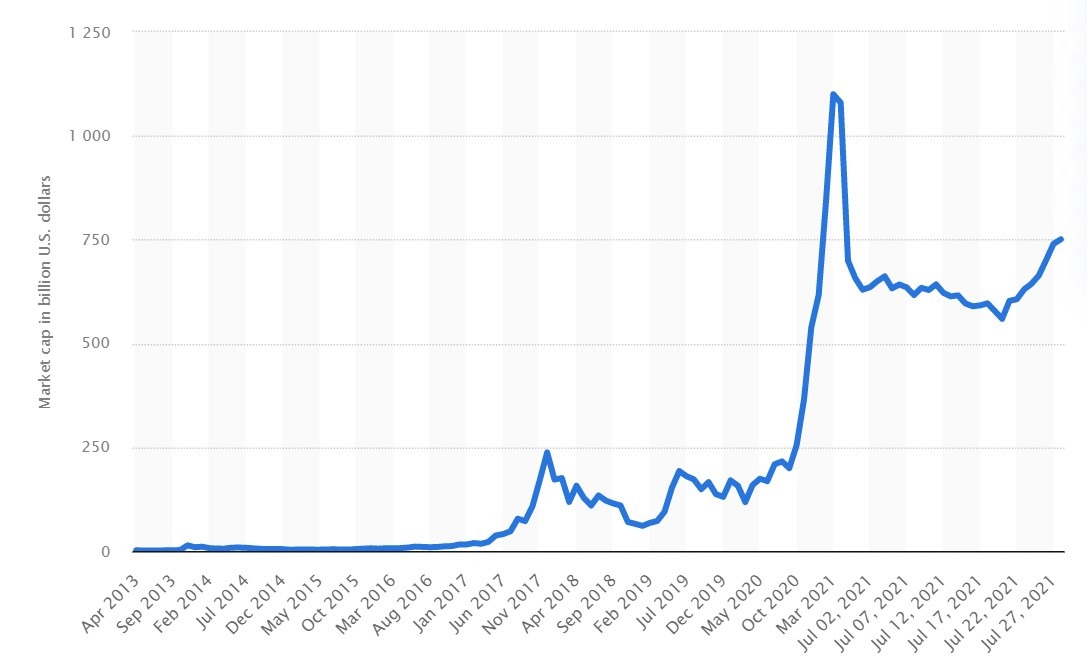
Ronnie Ali Rahman
Author
Bitcoin, the mother of cryptocurrency, was created by Satoshi Nakamoto in 2009. Since then Bitcoin has grown massively with a more than 1000% increase from Jan 2016 to Jan 2017. As of today, 1 bitcoin is over $34000 and each bitcoin can be divided into 100 million units.

Bitcoin price history and factors that influence current Bitcoin price. Source: unsplash.com
Bitcoin’s primary feature is that it is decentralized, meaning no central authority or government regulates it, unlike other currencies or commodities. According to a report on Statista, when compared to the warmer months, the Bitcoin market cap achieved an all-time high in April 2021, having grown by over 1,000 billion dollars. Since then, the market capitalisation has fallen, reaching around 600 billion dollars in June 2021. The total amount of Bitcoins in circulation is multiplied by the Bitcoin price to determine market capitalization. Since its meteoric rise in popularity in 2017, Bitcoin’s market valuation has risen from around one billion dollars in 2013 to many times that amount.
Price history
In the last ten years, Bitcoin investors have mostly had a rough journey. Apart from daily volatility, where double-digit coin price increases and decreases are usual, they have had to deal with a slew of issues affecting their ecosystem, ranging from many scams and fraudsters to a lack of regulation that adds to its volatility. Despite this, there have been times when cryptocurrency price fluctuations have exceeded even their typically erratic swings, culminating in huge price bubbles.
The first time this happened was in 2011. Bitcoin’s price rose 3200 per cent in three months, from $1 in April to $32 in June of that year. Following that fast rise, the crypto markets saw a dramatic downturn, with Bitcoin’s price bottoming out around $2 in November 2011. The next bitcoin price boom began in 2013 and unlike previous rises, this one gathered steam steadily over a long period. The Bitcoin price increased from $13.98 in January to around $195 in December, a huge increase of about 1500 per cent over the year.
That, however, was not the end of it. Toward the conclusion of the year, another surge (and subsequent crash) took place. The coin was trading at $123.20 in early October. It had risen to $1156.10 by December. It had dropped to around $760 three days later. These quick fluctuations heralded the start of a multi-year decline in Bitcoin’s price, which peaked at $315 in January 2015.
In 2017, the fifth price bubble popped. At the start of that year, the cryptocurrency’s price was hovering around $1,000. The price skyrocketed from $975.70 on March 25 to $20,089 on December 17 after a slight drop in the first two months.
For the next two years, the price of bitcoin moved slowly. In the gaps, there were signs of life. In June 2019, for example, the price and trading volume both increased, and the price topped $10,000, rekindling prospects of another gain. During the same year in December, it had dropped to $7,112.73.
When the economy was shut down due to the epidemic in 2020, Bitcoin’s price began to increase again. At the start of the year, bitcoin was worth $7,200. The pandemic closure, as well as following government policy, exacerbated investors’ concerns about the global economy, hastening Bitcoin’s growth. At the closing of business on November 23, bitcoin was worth $18,353.
In March, the pandemic took a toll on the stock market, but following stimulus checks of up to $1,200 may have had a direct impact on the markets. Following the release of those checks, the entire stock market, including cryptocurrency, had a massive rebound from March lows, even surpassing prior all-time highs.
These checks heightened fears about inflation and the dollar’s ability to lose purchasing value. Because the supply of Bitcoin is limited to 21 million, money printing by governments and central banks has bolstered the narrative of Bitcoin as a store of value. Instead of only ordinary investors, who were mostly responsible for the price increase in 2017, this story began to pique the interest of institutions.
In December 2020, the price of bitcoin was slightly under $24,000, up 224 per cent from the start of the year. In January 2021, Bitcoin shattered its previous price record and surpassed $40,000 in less than a month. The cryptocurrency hit a new high of $41,528 on January 8, 2021. But after three days, it had dropped to $30,525.39 again.
Factors that influence current Bitcoin price
Liquidity was scarce in the early days of Bitcoin, and there were few investors in cryptocurrency markets. When investors booked profits or adverse business development, such as a ban on cryptocurrency exchanges, this situation resulted in large price swings. Bitcoin’s price was also influenced by the emergence and fall of cryptocurrency exchanges that held large amounts of Bitcoin.
In recent years, the matrix of factors impacting Bitcoin price has altered drastically. Regulatory developments have had a significant impact on Bitcoin’s price since it gained public notice in 2017 because they broaden the cryptocurrency’s reach. Depending on whether the regulatory news is positive or bad, Bitcoin prices rise or fall.
The single largest factor affecting Bitcoin’s value is the level of demand for Bitcoin and its use cases. Demand is determined by factors that influence how widely individuals are willing to accept Bitcoin as a currency and as an investment asset, which differs from country to country. Different factors affect different countries at different times because there is no inherent global trend in terms and conditions.
Institutional investors’ interest has also thrown a long shadow over Bitcoin’s market volatility. In the last 10 years, Bitcoin has shifted its focus away from regular investors and toward institutional investors. This is viewed as a positive development because it adds liquidity to the ecosystem while reducing volatility.
The cryptocurrency’s most recent rally in 2020 happened after numerous well-known financial figures praised its potential as a store of value to protect against inflation caused by increased government expenditure during the pandemic. The adoption of Bitcoin for corporate treasury management boosted its price in 2020. MicroStrategy Inc. (MSTR) and Square Inc. (SQ) have both stated that their corporate treasuries will use Bitcoin rather than cash.
The third key factor influencing Bitcoin’s price is industry advancements. Because of Bitcoin’s unique origins, which span both technology and finance, these advancements are relevant to both industries.
The introduction of Bitcoin futures contracts in 2019 by the Chicago Mercantile Exchange (CME) led to an increase in institutional investor interest. Aviato, a Bitcoin trading software company, found that short-term speculators were taking large positions with leverage on CME’s futures market. This caused an unexpected spike in price during June 2017.
The introduction of Bitcoin futures contracts also helped include a broader range of investors. CME’s contract allows traders to bet on the future price of Bitcoin with an expiry date, rather than buying and holding Bitcoins until they believe prices will rise. The trading volume in Bitcoin futures allowed for greater liquidity as well, which brought prices up over time.
Finally, economic instability is a predictor of Bitcoin price swings. Cryptocurrency has established itself as a global hedge against local economic volatility and government-controlled fiat currency since its creation. According to studies, after an economy hits a snag owing to government policies, there is a time of greater economic activity on Bitcoin’s blockchain. Countries like Venezuela, where the currency has experienced hyperinflation, have seen a massive surge in the usage of Bitcoin as a means of transaction and wealth storage. This has led some observers to conclude that the rise in cryptocurrency prices and the global economic downturn are linked.
SEE ALSO:










